Jun
28

Four tour guides and a driver of Rainforest Expeditions picked us up from the airport, put our luggage on top of the bus and took us to the office (about a 15-minute ride from the airport) for welcome drinks (cocona juice).

Our first boat ride in Peru. The boat ride to our lodge was about 2.5 hours, and we ate fried rice.
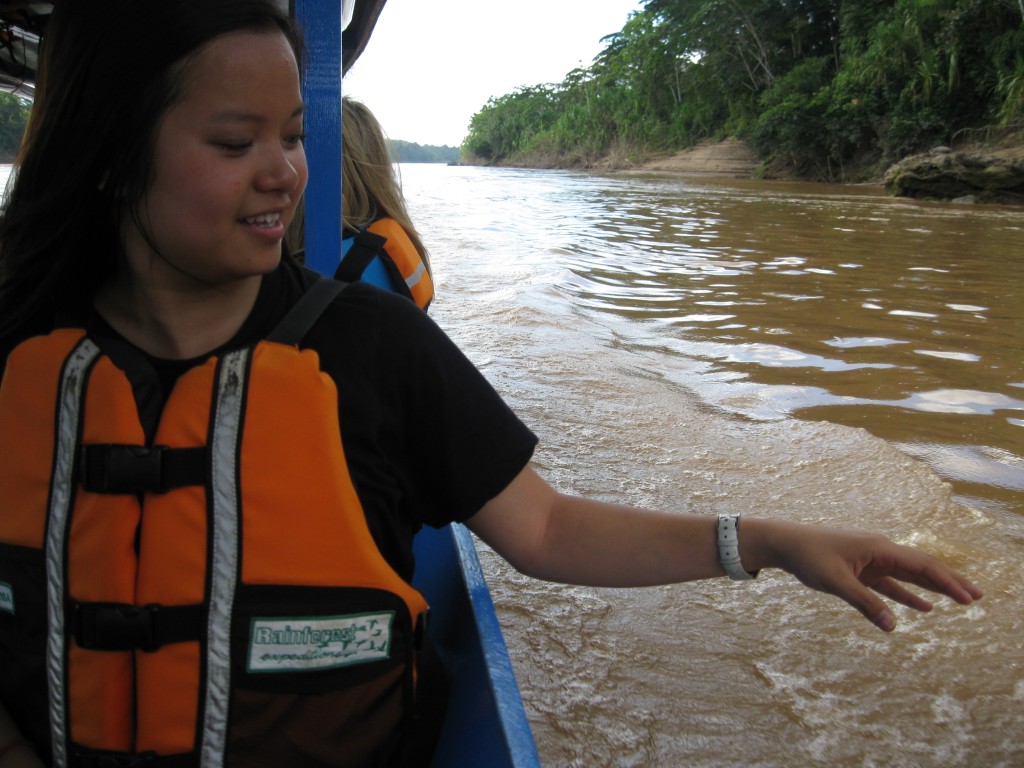
The rice was inside banana leaves, so we were able to throw our trash in the river. I love that the people try to have biodegradable products.
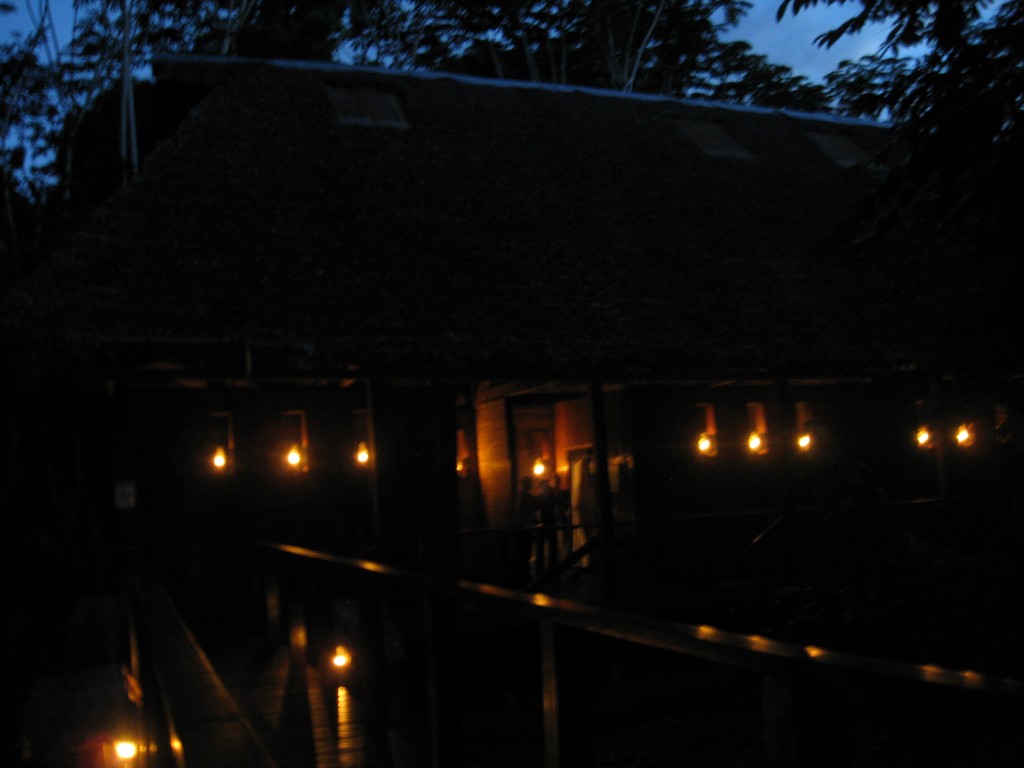
It was dark when we arrived to our lodge, but lines of kerosene lamps beautifully lit it.
We left the hotel around 9 a.m. and dragged our luggage through the small streets of Cuzco to where the bus was waiting for us. My luggage was top-heavy, and it flipped over eight times. We also had llamas in our way.
Rafael and his wife met us at the airport with our tickets, and we took a last picture with them. Rafael was thankful for the tip and the OU hats. He wore the OU hat immediately!
Our flight from Cuzco to Puerto Maldonado was about 30 minutes, and we saw beautiful views while flying.
Four tour guides and a driver of Rainforest Expeditions picked us up from the airport, put our luggage on top of the bus and took us to the office (about a 15-minute ride from the airport) for welcome drinks (cocona juice). We rested and left our big luggage, the luggage we would not need for the next five days, there.
Next, we took a 45-minute bus ride to the dock while munching on our snacks (banana chips, sugar-coated Brazilian nuts, an orange and cocona juice) and listening to a tour guide inform us about Puerto Maldonado.
We picked someone up on the way to the dock. I offered to let the man sit by me. He was very nice, and I practiced Spanish with him. He told me his name is Pedro and that he’s from the area. He later helped us load our bags on to the boat.
The boat ride to our lodge was about 2.5 hours, and we ate fried rice. The rice was inside banana leaves, so we were able to throw our trash in the river. I love that the people try to have biodegradable products.
There are three lodges along the Tambopatha River owned by Rainforest Expeditions; ours is called Refugio Amazonas, and it is the second lodge.
We stopped a few times to look at caimans, turtles, birds, capybaras (the largest living rodent in the world; looks like a giant guinea pig) and howler monkeys. We also stopped at the National Tambopatha Reservation to register, pay fees and get our passports stamped (the stamp is not mandatory; just for fun).
I can’t believe I am in the Amazon! It was neat to see our lodge at night surrounded by kerosene lamps. I was excited to see what it would look like in the morning.
Our rooms have mosquito nets and only three walls…this means pumas, snakes and other critters may be cuddling with me tonight! We put our snacks and medicine in a vault so we don’t attract animals. Our showers are all-around see-through with no hot water–talk about embracing nature!
We had cream of tomato soup, tallarines saltado de lomo, yucca fries and rice and milk pudding by candlelight prepared by our lodge in the Amazon. I find it amazing that our food is cooked with stone pots and coal, our towels are handwashed, we use kerosene lamps and candles…but we have Wi-Fi at certain hours. Welcome to the 21st century in the Amazon!
We went hunting for caimans in a canoe-like boat in pure darkness finding some baby caimans! As we hiked to the dock, we encountered many spiders the size of my hand! Welcome to the Amazon?
Our lodge and my first night in the Amazon: We have only three walls in our room, and they’re made of bamboo and thin with no doors or windows; showers have clear curtains, toilet stalls have curtains; hot and humid; no electricity or hot water; bugs and bats: candles with a broken lighter; I heard snoring, talking, animal noises throughout the night; I sprayed my mosquito net with 40% deet bug spray while in it and couldn’t breath. Just a few of the many Amazon adventures!
Jun
26
My time here in Lima is winding down. I can’t believe I only have two weeks left. This next week is finals week excluding Tuesday which is a holiday for the pope. I have tests Monday and Wednesday and a take-home test that will be handed out Thursday. Then on the Tuesday of my last week here, I have an oral exam and a paper to turn in (test would have been during finals week if not for the holiday.)
I’m not too stressed about my tests. If I study, I should be fine.
I’m looking forward to having a little free time after my tests are all finished. I’ll have about 5 free days in Lima to do some reflecting on my time here and go to places for my “lasts”. I think it’ll be nice to sit back and think about what this experience has meant to me, being able to evaluate it without worrying about the responsibilities of school and with the advantage of hindsight.
My restaurants/foods to try list consisted of:
Restuarants:
Rocoto Relleno–yet to be checked off.
Limeño Traditions–closed down
Don Rosalina–check! great Italian food
Como Agua Para Chocolate–check! great Mexican food
Mi Carcochita–good mexican–not as good as como agua (above)
La Rosa Nautica–check!!!! beautiful, amazing atmosphere, fantastic service, wide selection of food!
Foods:
cuy: check! unimpressed—boney, came with a face and paws, little meat
anticuchos–not yet
ceviche–check! really liked it–very unique flavor. not my favorite food, but a great experience!
pollo a la braza-check! just like any other roasted chicken i’ve ever had haha but they love it here.
Places to visit/ visit again and things to do before I leave:
–Park near my house–this is where I want to do some looking-back on my trip.
–Miraflores–Larco Mar/ beach
–Japanese Restaurant with friend from school
–Souvenir shopping
–hamburger near school again (There is a hamburger kiosk across the street from Católica. This guy’s hamburgers are famous with the students–they call him Tio Bigote. Mine was great, but not necessarily for the meat haha there is a lot of stuff on these burgers. I asked for a burger with cheese,but he handed me a burger with egg. I took it 🙂 There were swarms of people crowding the stand, and I knew I would never get another if I turned it down.)
–Center of Lima–museums and catacombs
–Museo Larco
–5 estaciones
–Tortas emily’s
–Hang out with my Peruvian friends
Jun
26
Arte por La Memoria
Last week during my Justicia class, a group from the organization “Arte por La Memoria” came and presented. We all waited outside while they set up. When we entered, a somber tone was set. We were asked to only sit in chairs with photographs. The group explained the organization´s objectives, showed a video, explained a beautiful display of artwork created by a group of women named Mama Quilla, and then lit candles for the altar colectivo.
Their objectives: (from their website :http://arteporlamemoria.wordpress.com/)
¿Qué queremos?
-Recuperar memoria (Recuperate memory)
-Evidenciar silencios cómplices (Demonstrate silent accomplices–I think this means give a voice to those who can’t tell their story through conventional means–like writing or even vocally b/c of language barrier,etc.)
-Reivindicar a las y los afectados (Vindicate the victims)
-Ser una forma de reparación simbólica para las y los afectados del conflicto. (Be a form of symbolic reparation for the victims of the conflict)
-Democratizar plataformas de exhibición y consumo de arte y lograr un trabajo articulado entre varios actores.
(Democratize platforms of exhibition and consumption of arte and acheive a work articulated between various actors)
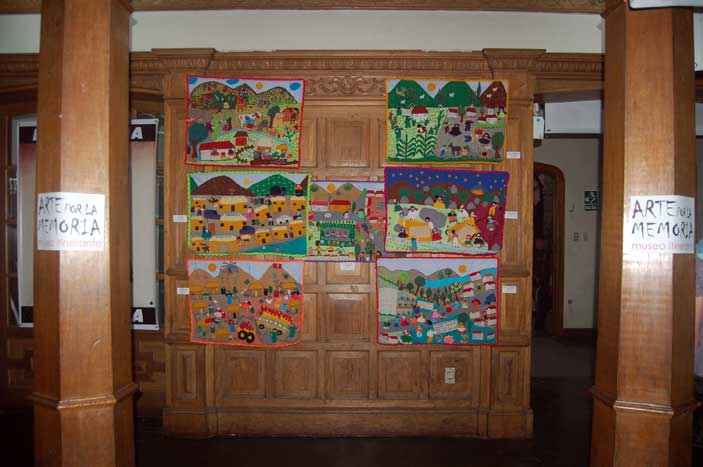
Arpilleras Mama Quilla de Huaycán. This was one of the coolest works of art I have ever seen.
The arpilleras de Mama Quilla de Huaycán (these decorated clothes tell the story of a population of people who migrated to the outskirts of Lima during the conflict) :
Top Left: How their small village was before the conflict arrived there.
Top Right: Their village after the Senderistas y Fuerzas Armadas arrived
Center Right: The villagers hiding in the hills.
Center Left: The village they set up on the outskirts of Lima: Huaycán
Bottom Left: But the conflict came to Huaycán too.
Bottom Right: Their march to the plaza de armas in Lima to demand water and electricity (which they received as a result).
Center Center: What the villagers hope for their town in the future. You can see children playing soccer.
The collective altar:
In my seat was the foto of Saul Cantoral Huamani (Lima) who was assasinated on February 13, 1989. I was the first one up at the altar. I set his foto on the table and lit a blue candle in his memory. One of the seats next to me was empty (student-wise), but sitting in the seat was the foto of Felix Huaman, a journalist–so I placed his foto on the table as well. I felt his memory should be honored too.

Altar Colectivo
Cajamarca
Last weekend, Calin and I finally made it to Cajamarca.
We took a Tepsa bus. It is a 14 hour trip. We left Lima at 4:15 on Thursday afternoon and arrived in Cajamarca at 9am on Friday morning (took longer than normal–our bus was stopped several times along the way). Cajamarca is known for its delicious milk products and historical sites (Atahualpa–the last Inca was executed here). I must admit I liked the historical sites better than the food, although we did buy some yummy manjar blanco.
On Friday, we ate breakfast at the Tuna Cafe. I had a sunny-side up egg (result of inadequately explaining over-easy), bacon, and pineapple juice. We visited the Iglesia de Belén, ex-hospital for men, ex-hospital for women (made into a museum), and the cuarto de rescate (Atahualpa ransom room). We purchased the tickets for these 4 places in a bundle deal for only 2.5 soles a piece with our student discount. Then we payed 7 soles for a tour guide (worth it if only for a funny memory). After that tour, we visited a San Francisco church with catacombs and a museum outback. Then we tried our first cuy (guinea pig). I have to say I wasn’t too impressed and kind of grossed out haha. It came with a face, teeth, paws,a TON of bones, and little meat. After dinner, we headed for a musical we had seen advertised. Turned out it was at a high school 🙂 It was actually pretty good. They performed Oscar Wilde’s “The Ghost of Canterbury.” I loved loved loved the little kid ghosts.

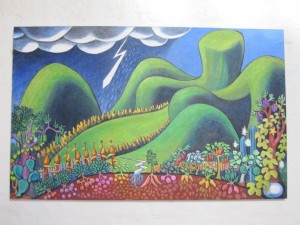
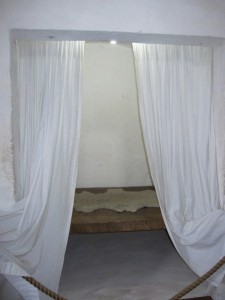

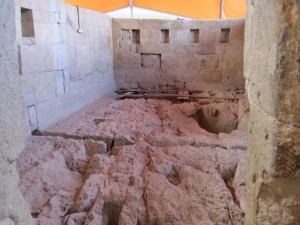
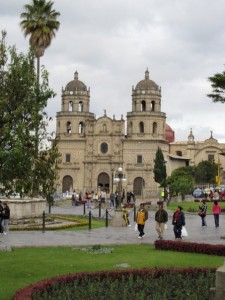
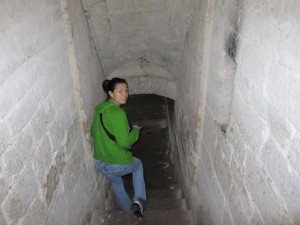
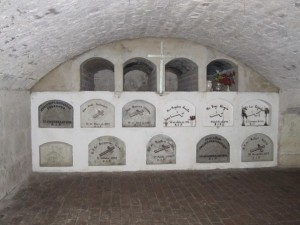
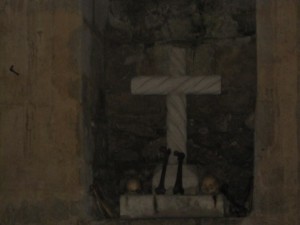
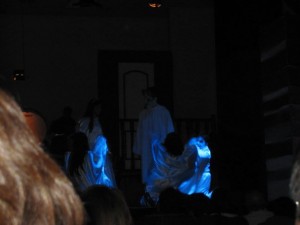 On Saturday, we visited the Baños del Inca–ancient thermal baths-about 10-15 minutes from Cajamarca. In addition to showing off the old, they now offer a heated pool, saunas, hot showers, massages,etc. We didn’t partake in the new–just checked out the incan baths 🙂 they were pretty cool. After returning to Cajamarca, we ate the menú at the Tuna Cafe: palta rellena, lomo saltado, a gross dessert haha, and chicha morada ( i liked it!). Then we trekked up to Santa Apolonia, the mirador, and the Incan seat.
On Saturday, we visited the Baños del Inca–ancient thermal baths-about 10-15 minutes from Cajamarca. In addition to showing off the old, they now offer a heated pool, saunas, hot showers, massages,etc. We didn’t partake in the new–just checked out the incan baths 🙂 they were pretty cool. After returning to Cajamarca, we ate the menú at the Tuna Cafe: palta rellena, lomo saltado, a gross dessert haha, and chicha morada ( i liked it!). Then we trekked up to Santa Apolonia, the mirador, and the Incan seat.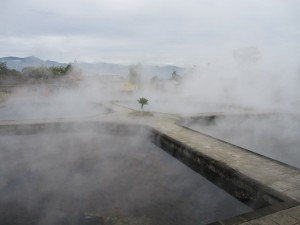

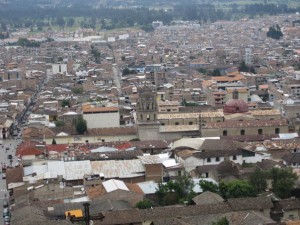
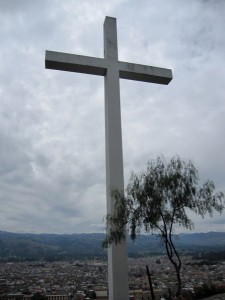
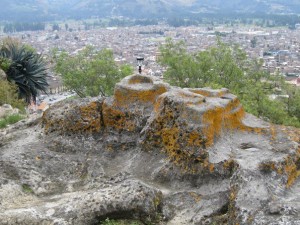
We took a 6:30 bus back to Lima and arrived around 9 am on Sunday morning. It was all in all a great trip, and I’m so glad we FINALLY made it!
Jun
20
Where to start?
I’m in Arezzo now and it is so beautiful. It smells like flowers here. We are staying in a monastery, which I love. I have a nice room that I share with two girls from the program. The monastery provides two meals a day, which is great for saving money. I feel like I have finally settled down. I go to class in the mornings and then excursions or walks around Arezzo with my professor in the afternoon.We are learning some really interesting things about fascism and the false medieval appearance of Arezzo.
I have had the most amazing food. One one of our excursions, we visited Michelangelo’s birthplace. Since I had already seen his final resting place, it felt right. Nearby, we had lunch at a restaurant that, from the outside, looked like a sandwich shop. You could walk up to the front and buy newspaper or gum, but the food we had was out of this world. They made a lasagna with the freshest pasta I’ve ever had and cream sauce and truffles. There are no words good enough to describe this dish.
The most exciting thing so far has been the Joust of the Saracen. It is a very important tradition here in Arezzo. It seems medieval, with horses and knights and processions, but in reality it is just an abstraction of a tradition by the fascists. Nevertheless, it’s a big deal. The entire town gets involved. Everyone belongs to one of four neighborhoods or “quartieri.” Our professor put us into groups, too. Mine was Porta Santa Spirito. The others are Porta del Foro, Porta Sant’ Andrea, and Porta Crucifera. On last Friday night, we all went to our separate neighborhood dinners. The food was good, but there were many rowdy young men. I suggest staying away from rowdy groups of Italian men. They have limited interests. The next night, we went to the actual Joust or “Giostra.” It is a joust against a dummy (the saracen) and not other knights. It took a long time, which was surprising because horses are fast and the actual jousting goes by very quickly. The traditions and processions and arguing about points are what took so long. It was like Arezzo’s personal Superbowl, with horses and flags. When it was over, my team lost. It’s amazing how quickly I got invested in a neighborhood and team to which I don’t even belong.
I am looking forward to this week. The school part of it will be short and then we have a long weekend, where almost my entire group is going together to Cinque Terre. I have only heard good things about this place, but I am not sure what to expect. Every day here has brought some new experience. One day it might be seeing a joust and another it is learning how to order a kebab in Italian. Actually, those both happened to me yesterday. I recommend the roasted zucchini.
I was going to use the rest of this post for pictures, since I have so many to share, but the internet will not comply. I will try again soon. It will probably just be a long post of photos from the past two weeks. Then I’m sure I’ll post again about the wonders of Cinque Terre.
Ciao!
Jun
20
A review of Saturday, June 19, 2010
Today was our free day in Cuzco!
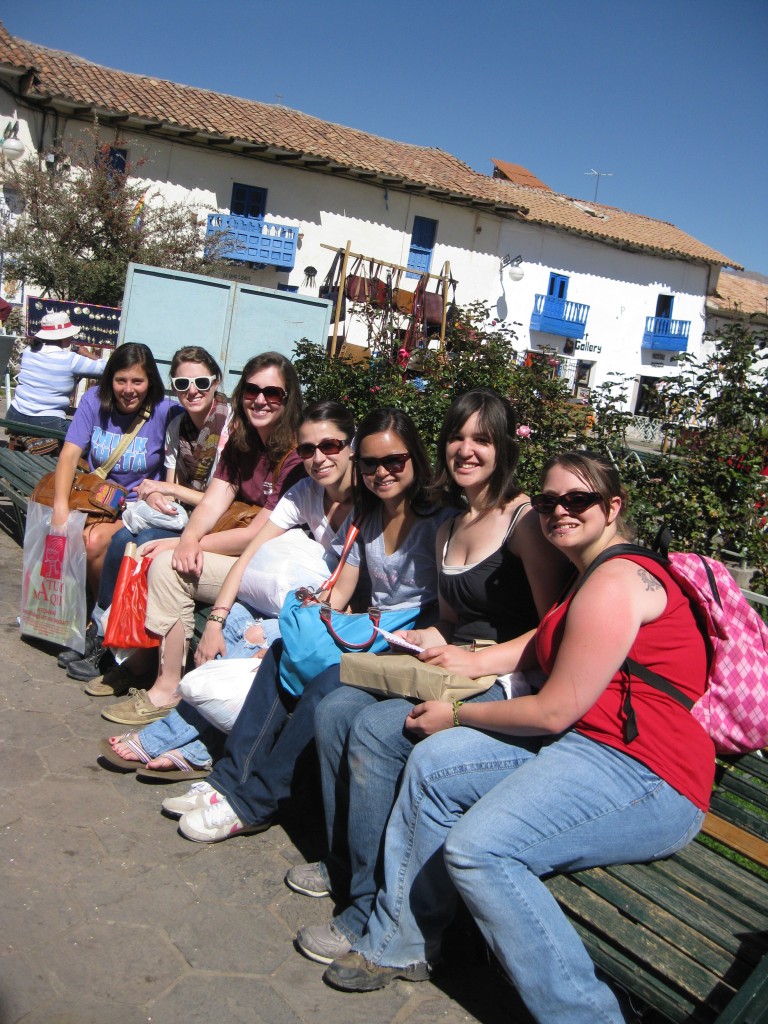
We visited the Saturday arts and crafts market in San Blas Plaza. I bought many precious handmade goodies including hair accessories, Delta-shaped earrings, Alpaca fur socks, a ceramic nativity scene, magnets and a leather photo album--just helping the Andeans. 🙂
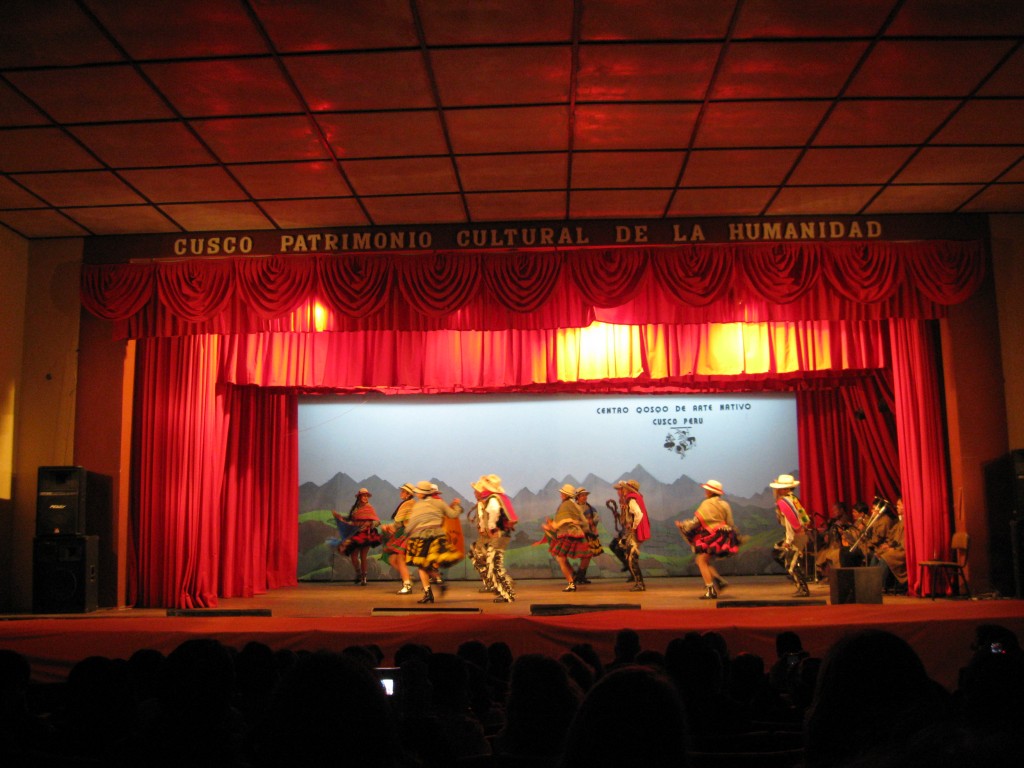
After Mass, we went to a native cultural show with traditional dancing and singing in Quechua. The women sing in very high voices. Each performance included different dances and costumes from various areas of Peru.
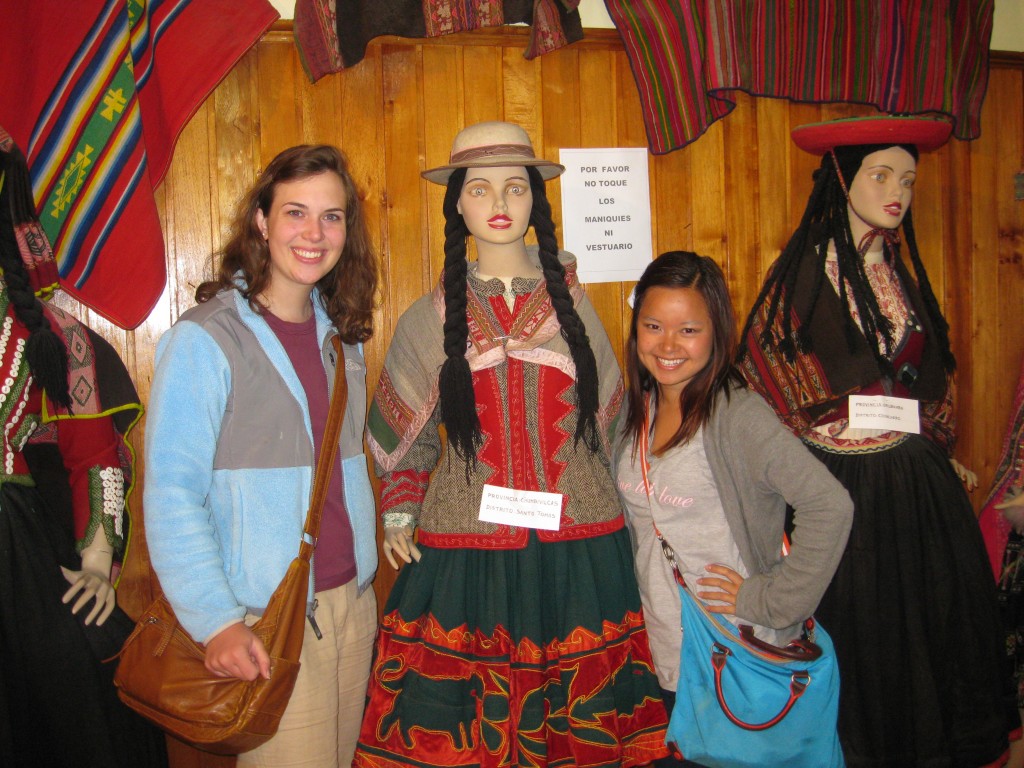
During intermission, we looked at traditional clothing from the different Peruvian regions.
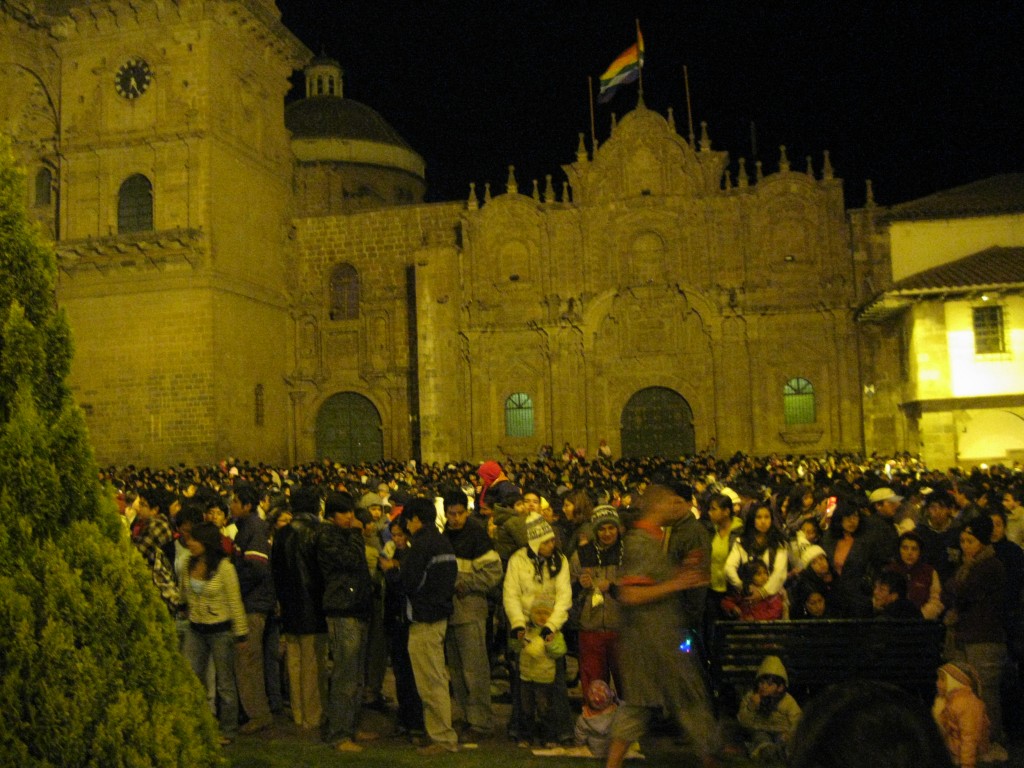
After the native show, we power walked through the mass of people to the Plaza de Armas for tonight's big celebration in preparation for one of Peru's biggest festivals, Inti Raymi, the Incas' honor of the Sun God. There was a live concert, fireworks and all kinds of food like a giant carnival or fair. I've never seen so many people in one place. What a great last night in Cuzco!
The official flag of Cuzco consists of the colors of the rainbow because it’s the Inca flag. The mayor requires all businesses to have the flag displayed. Our tour guide from yesterday, Jimmy, said many tourists are confused and think Cuzco is a gay community until they find out its origin from the Inca Empire. Isn’t it interesting how institutions differ in how they look at the same things?
We visited the Saturday arts and crafts market in San Blas Plaza. I bought many precious handmade goodies including hair accessories, Delta-shaped earrings, Alpaca fur socks, a ceramic nativity scene, magnets and a leather photo album–just helping the Andeans. 🙂
We spent about two hours at the market, and returned to the hotel in time for lunch. We had lomo saltado, my favorite Peruvian dish.
We collected money from the group to give Rafael and Saúl for tips. I’m giving Rafael and his wife OU hats, and I’m giving Saúl an OU clock. There are few things better than spreading the Sooner spirit!
Dr. Kenney and his wife, Señora Marchand, Lori, Carlee, Jane and I went to Mass at the Jesuit Church in the Plaza de Armas. It’s beautiful! The precious priest was old and physically fragile–I wanted to give him a hug! I smiled at him when I went up for communion, and he gave me the biggest grin (the first smile I saw from him that night) then patted my face. Thank you, Jesus, for reminding me that a smile goes a long way! God is Good.
After Mass, we went to a native cultural show with traditional dancing and singing in Quechua. The women sing in very high voices–I feel like I could be a star in these shows with my voice. Each performance included different dances and costumes from various areas of Peru. During intermission, we looked at traditional clothing from the different Peruvian regions.
After the native show, we power walked through the mass of people to the Plaza de Armas for tonight’s big celebration in preparation of one of Peru’s biggest festivals, Inti Raymi, the Incas’ honor of the Sun God. There was a live concert, fireworks and all kinds of food like a giant carnival or fair. I’ve never seen so many people in one place. What a great last night in Cuzco!
I found candy like M&Ms called Chin Chin. I’m pretty much famous here, but the makers just forgot the “H” like many do when they write my name.
I had gelato, starfruit flavored, for what may be the last time in Peru at a place down the street from our hotel called Dolce Vita.
I can’t believe we leave for the Amazon in the morning. Bye Cuzco, electricity, Internet, hot water and civilization; hello jungle, crocodiles, pumas, mosquito nets and NATURE!
Jun
20
A review of Friday, June 18, 2010

The Cuzco Cathedral has so many giant paintings, gold-covered adornments and original items from the Spanish conquest. One of my favorites from the Cuzco Cathedral is the painting of the Virgin Mary in which her eyes move like those of the Mona Lisa because the artist went to the same art school as Leonardo Da Vinci. Other fascinating things are the first cross the Spaniards brought to Peru and a silver-covered car only used for special religious celebrations.
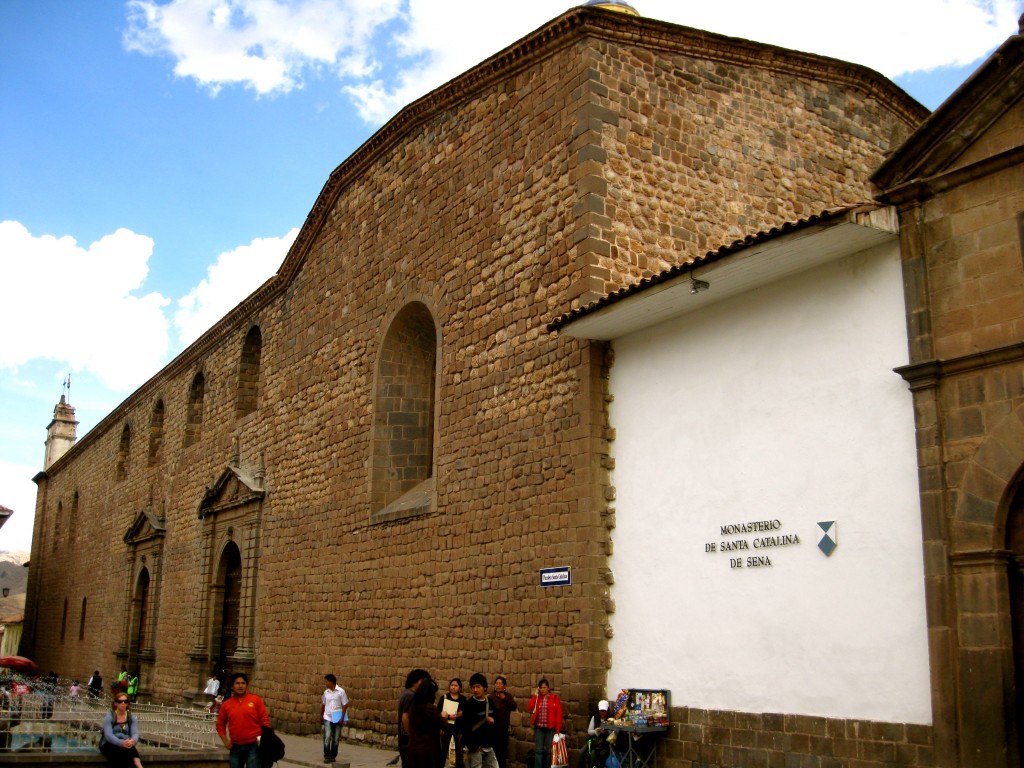
It’s interesting that the Santa Catalina Monastery for women was once the Incas’ haven for the Virgins of the Sun. The Incas and Spaniards had the same idea for the same location.
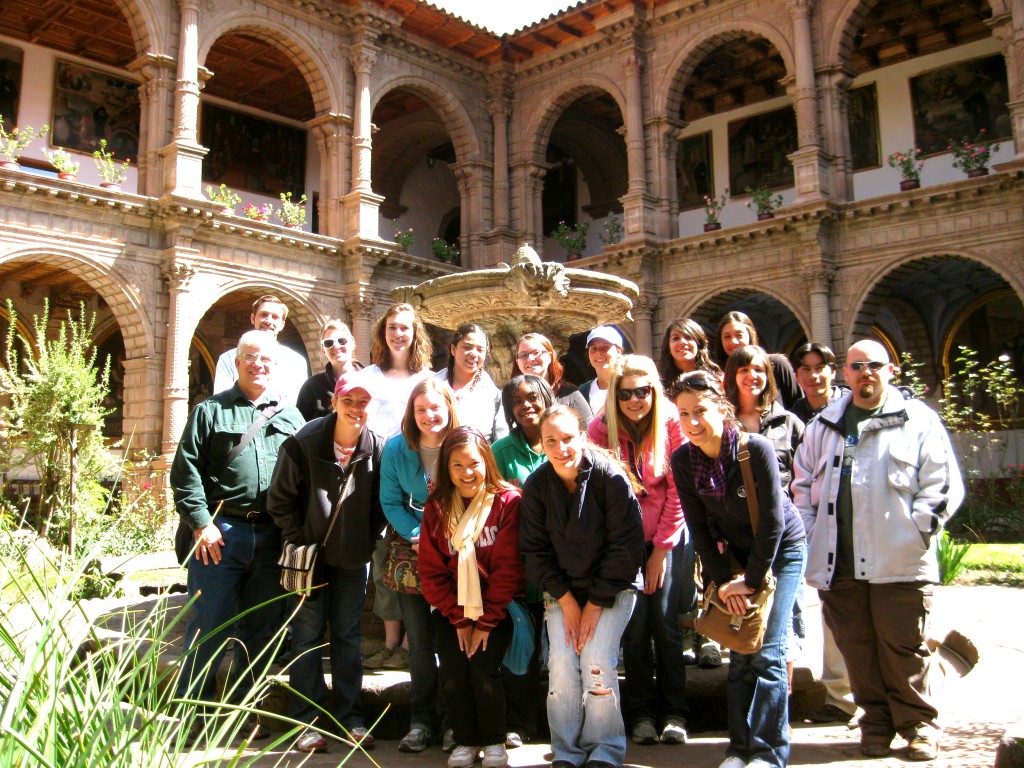
My favorite part about the La Merced Convent was the room in the basement once occupied by a priest. This priest lived in the room for 13 years without ever leaving, but it is believed that he left the room once a year for the celebration of Corpus Christi. He split the room in half, and painted one side to be Heaven and the other side to be Hell. He chose to sleep in the Hell side of the room and to live this way of life because he wanted repentance from his previous years in which he lived a life of sin.

San Blas Catholic Church is in San Blas Plaza, surrounded by art shops. San Blas has the most beautiful and detailed pulpit in Cuzco. It took the artist more than a decade to create the pulpit. The artist’s skull is placed on top of the pulpit to honor his dedication and work to the church. It once had a small crown made of diamonds, but it was stolen years ago.

The girls and I went out with our Peruvian friends, Saúl and his brother, to a show at Ukuku’s Cultural Pub. We watched two boys perform an indigenous dance involving scissors and bright costumes.
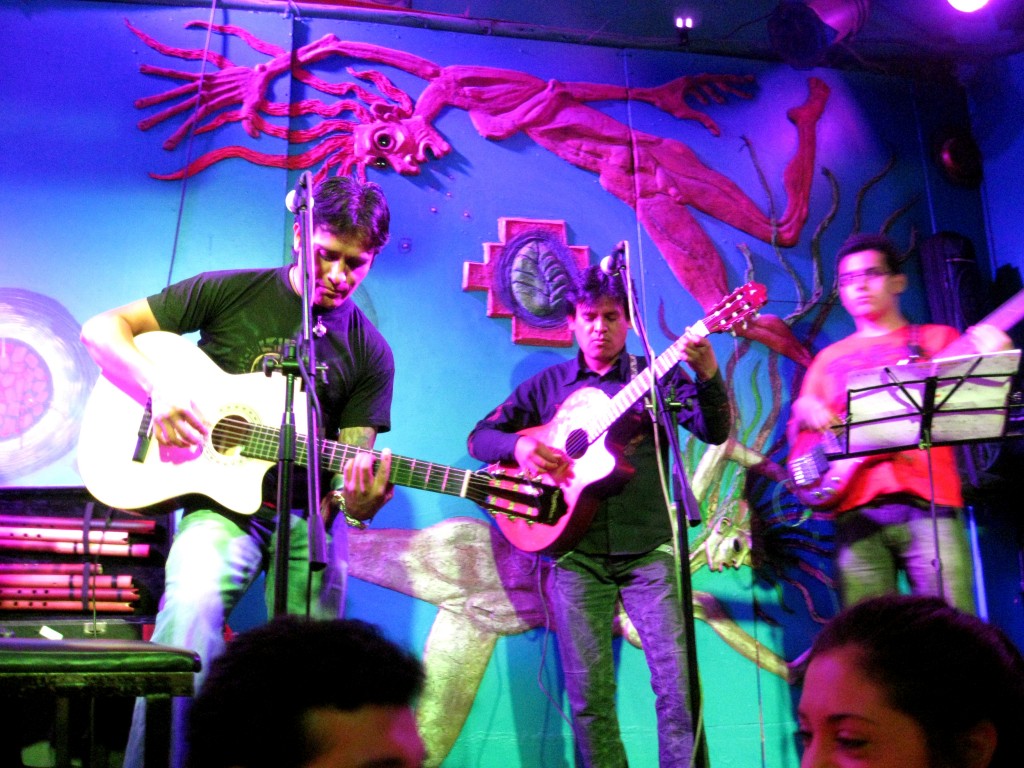
Ukuku’s Cultural Pub where we listened to a Peruvian band.
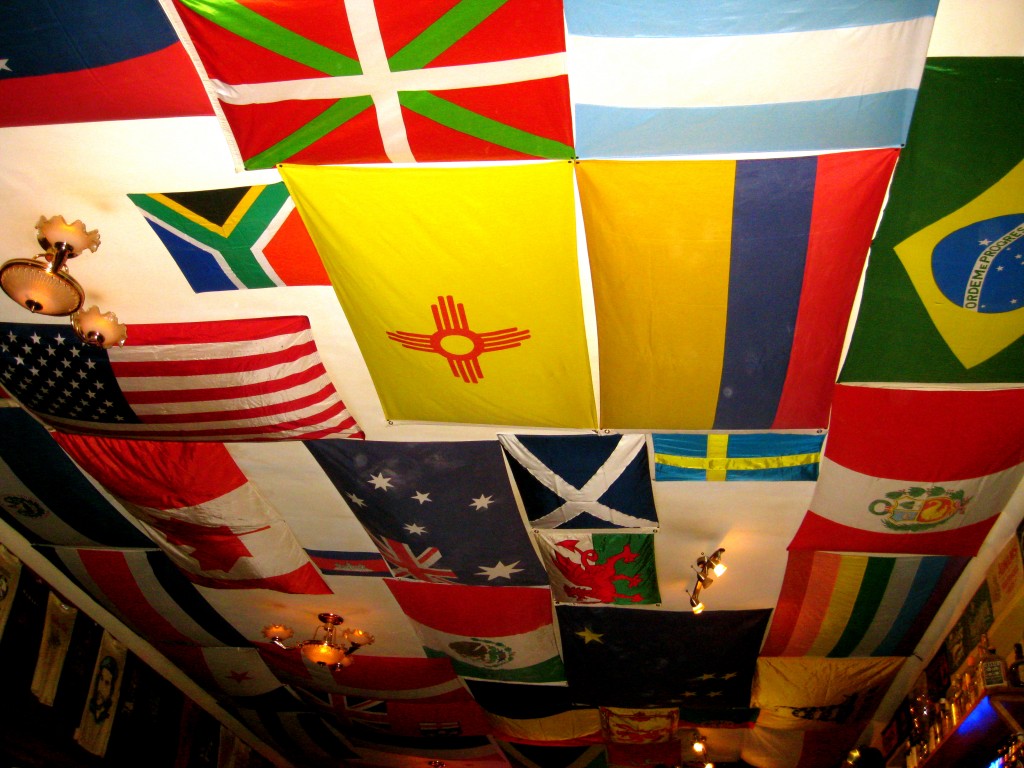
We had dinner at Norton's Pub in the Plaza de Armas. The ceiling of the restaurant is covered in flags from the world, and it has a tiny balcony that looks out to the plaza where people were celebrating the Inti Raymi! Most of us enjoyed hamburgers, grilled chicken sandwiches and fries there.
OU Journey to Latin America students visited the Cuzco Cathedral, Santa Catalina Monastery, San Blas Catholic Church and La Merced Convent.
All of these places were once Inca places of worship, and parts of the original structures are still standing.
The Cuzco Cathedral has so many giant paintings, gold-covered adornments and original items from the Spanish conquest. One of my favorites from the Cuzco Cathedral is the painting of the Virgin Mary in which her eyes move like those of the Mona Lisa because the artist went to the same art school as Leonardo Da Vinci. Other fascinating things are the first cross the Spaniards brought to Peru and a silver-covered car only used for special religious celebrations.
It’s interesting that the Santa Catalina Monastery for women was once the Incas’ haven for the Virgins of the Sun. The Incas and Spaniards had the same idea for the same location.
My favorite part about the La Merced Convent was the room in the basement once occupied by a priest. This priest lived in the room for 13 years without ever leaving, but it is believed that he left the room once a year for the celebration of Corpus Christi. He split the room in half, and painted one side to be Heaven and the other side to be Hell. He chose to sleep in the Hell side of the room and to live this way of life because he wanted repentance from his previous years in which he lived a life of sin.
San Blas Catholic Church is in San Blas Plaza, surrounded by art shops. San Blas has the most beautiful and detailed pulpit in Cuzco. It took the artist more than a decade to create the pulpit. The artist’s skull is placed on top of the pulpit to honor his dedication and work to the church. It once had a small crown made of diamonds, but it was stolen years ago.
It’s awesome learning more about the Catholic faith and seeing the result of the merging of Catholic and Andean/Inca symbolism in the architecture and art.
We later discussed Spanish colonization, presence of Catholic Church and observations from today’s visits to four Catholic institutions in tonight’s class in the courtyard of our hotel.
There’s traditional dancing and live, Andean music around Cuzco because people are celebrating the upcoming Inti Raymi, an Inca festival honoring the Sun God!
We had dinner at Norton’s Pub in the Plaza de Armas. The ceiling of the restaurant is covered in flags from the world, and it has a tiny balcony that looks out to the plaza where people were celebrating the Inti Raymi! Most of us enjoyed hamburgers, grilled chicken sandwiches and fries there.
The girls and I went out with our Peruvian friends, Saúl and his brother to a show at Ukuku’s Cultural Pub. We watched two boys perform an indigenous dance involving scissors and bright costumes and listened to a Peruvian band.
I finally have Wi-Fi to update my blog, but it won’t let me upload pics, so just visualize with me.
It’s funny that most of the tourists around here wear North Face…even the native wear (fake) North Face. I’m assuming the North Face the native wear are fake because I priced North Face clothing here, and it’s more expensive than in the United States. Plus, I have an eye for distinguishing between real and fake brands. Did the people of Cuzco start wearing North Face because many tourists wear North Face?
Our hotel in Cuzco, Casa Campesina, has unisex community restrooms and showers. So, it’s startling when we forget that, and we see a man walk out of the shower or stall. BUT our lunch is always delicious. You win some; you lose some!
One of my nostrils is constantly bleeding while the other nostril is constantly running. Thank you, chilly Cuzco and your high altitude! The Peruvian germs are attempting to make me sick…I must fight back!
Jun
19
A review of Thursday, June 17, 2010
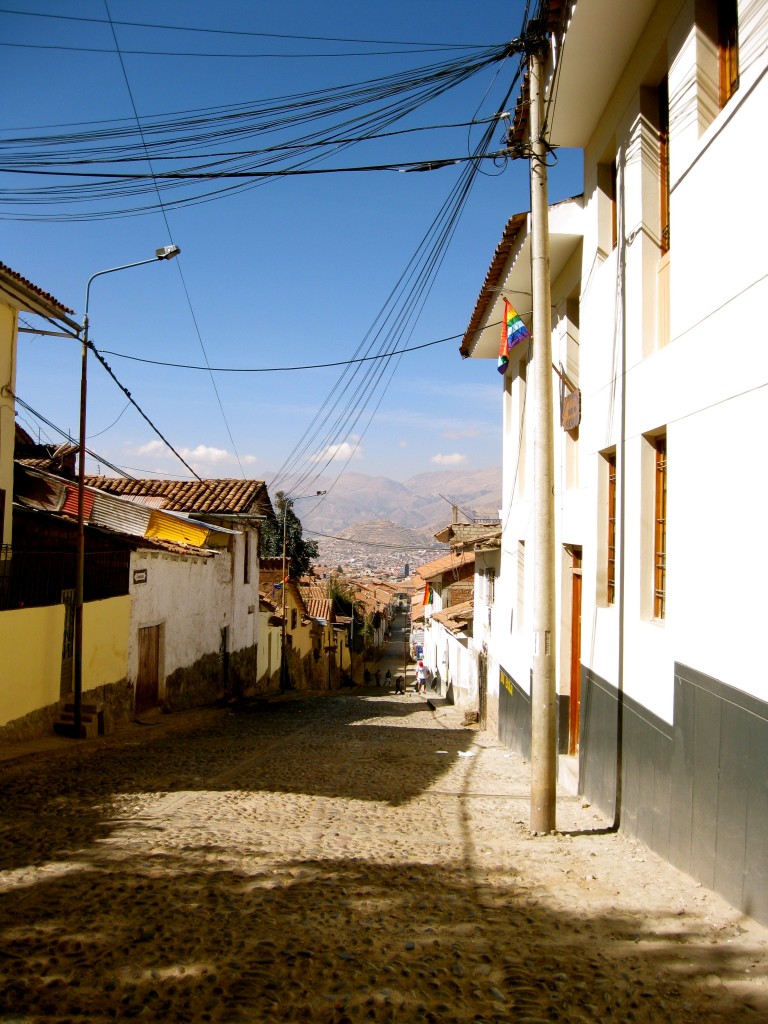
There was a strike today in Cuzco by some businesses and most automobile employees including bus drivers and taxi drivers, so no automobiles were found on streets. This was nice because Cuzco is crowded and full of cars. The strikers were parading around the Plaza de Armas.

Because of the strikes today, we were unable to drive anywhere. SO, we hiked to and climbed Sacsayhuaman, Inca ruins in Cuzco. The hike was about 25 minutes, but it was worth it. We were able to see the entire Cuzco area from the top and see it clearly due to lack of pollution since no cars were running today.
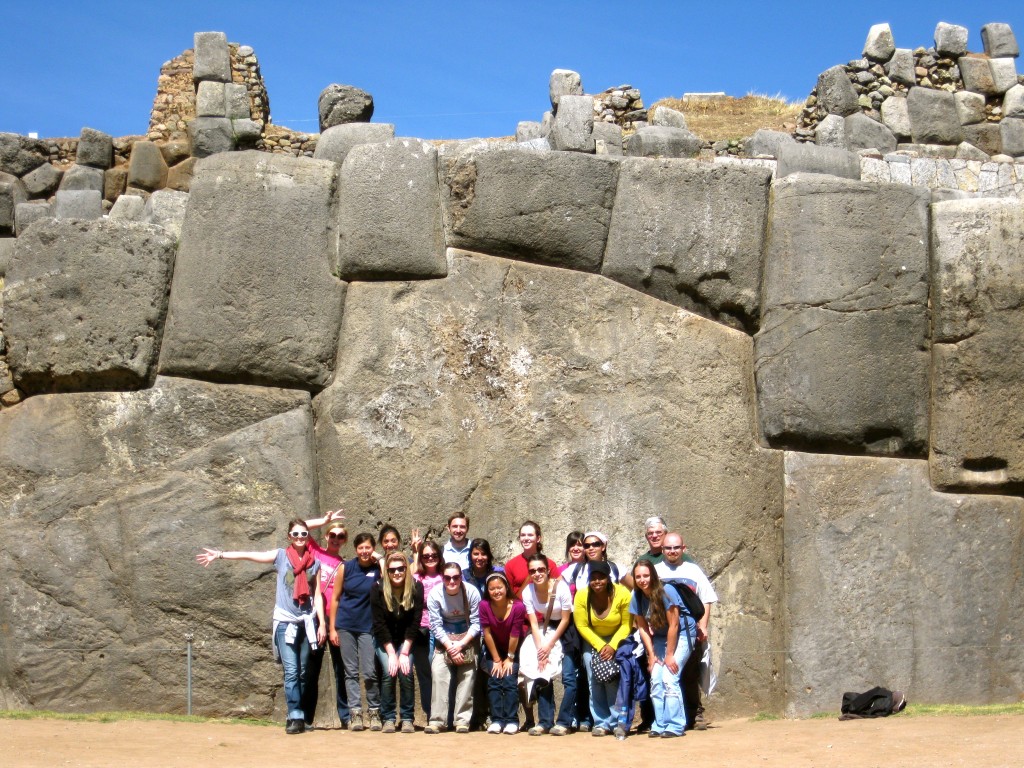
OU Journey to Latin America students at Sacsayhuaman, Inca ruins in Cuzco.
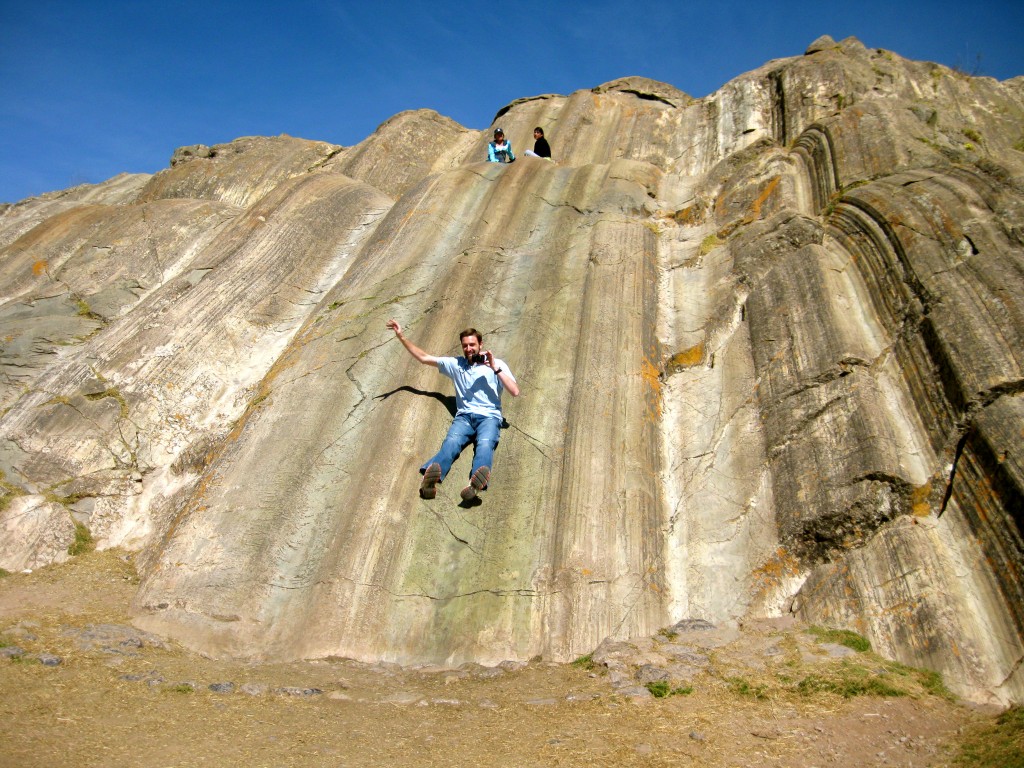
My favorite part about Sacsayhuaman was the natural slides. Rock erosion caused parts of the stone structures to be smooth and wavy, like playground slides. Inca children may have played on these naturally made slides.
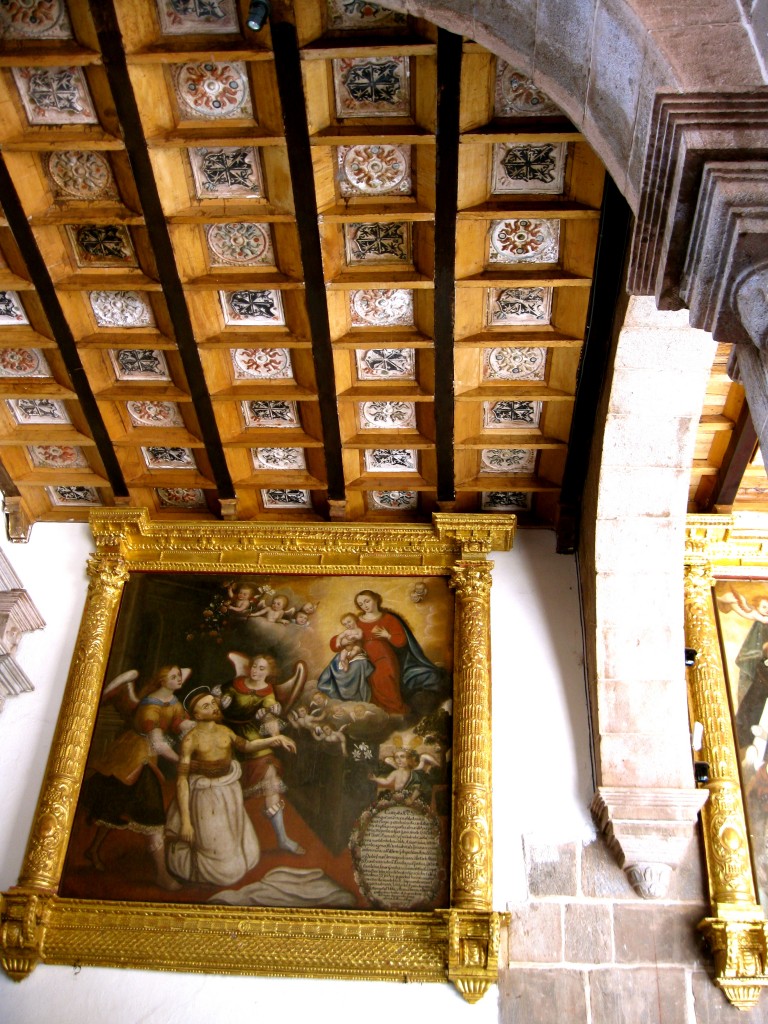
We also visited Santo Domingo Church and Convent. It was once an Inca temple, Qoriqancha (or Koricancha( but was rebuilt into a church and convent during the colonial period. There is a garden in the center of the structure. It was neat to see the mix of Incan and Spanish work.
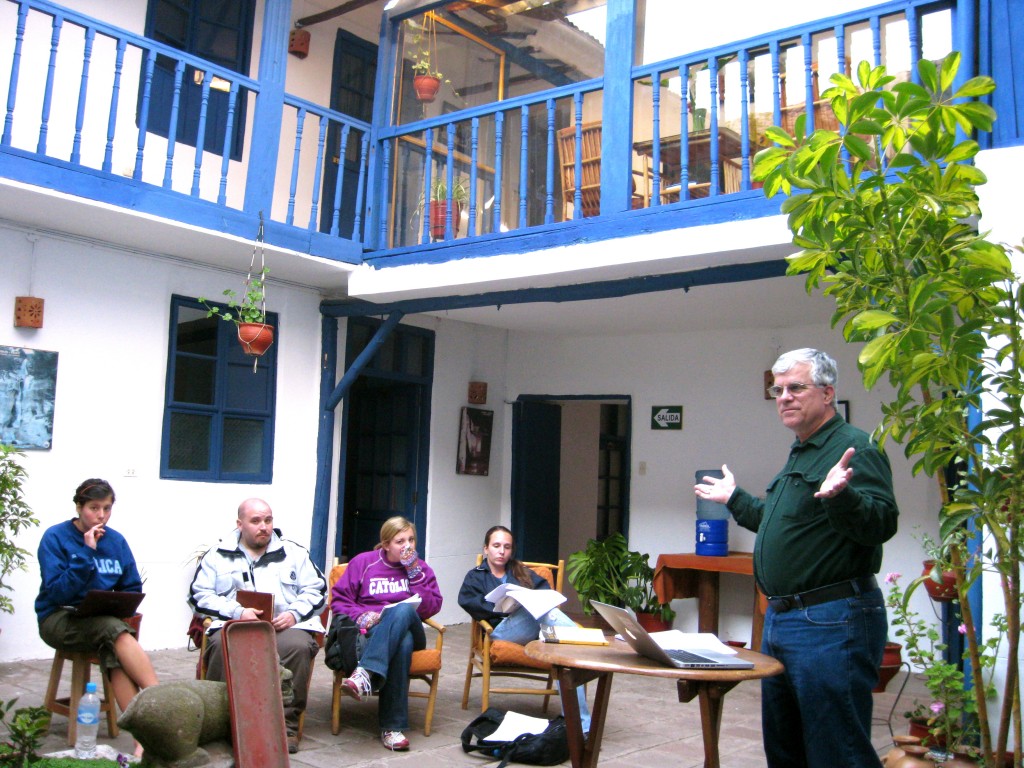
We later had a 3-hour class in the courtyard and multipurpose room of our hotel. We discussed our Machu Picchu experience and a famous Machu Picchu poem and watched a video about the Spaniards' conquest of the Inca Empire.
There was a strike today in Cuzco by some businesses and most automobile employees including bus drivers and taxi drivers, so no automobiles were found on streets. This was nice because Cuzco is crowded and full of cars. The strikers were parading around the Plaza de Armas.
So much excited today—we’re blessed to be here at the right time to witness all of this!
Because of the strikes today, we were unable to drive anywhere. SO, we hiked to and climbed Sacsayhuaman, Inca ruins in Cuzco. The hike was about 25 minutes, but it was worth it. We were able to see the entire Cuzco area from the top and see it clearly due to lack of pollution since no cars were running today.
We went through a stone tunnel at the Inca site. Saúl said the Incas believed this tunnel helped them pray and focus as they went through it. It was completely dark and small. Although I am claustrophobic, I’m glad I went through it to experience it.
My favorite part about Sacsayhuaman was the natural slides. Rock erosion caused parts of the stone structures to be smooth and wavy, like playground slides. Inca children may have played on these naturally made slides. We all went up and down these slides, and some went several times. We were told people get hurt and break their arms and legs every year while playing on these slides. The toughest part was climbing to the top of the slides because the rocks were slippery, but no one was hurt.
We also visited Santo Domingo Church and Convent. It was once an Inca temple, but was rebuilt into a church and convent during the colonial period. There is a garden in the center of the structure. It was neat to see the mix of Incan and Spanish work.
We had a very delicious buffet lunch at the hotel, Casa Campesina.
We later had a 3-hour class in the courtyard and multipurpose room of our hotel. We discussed our Machu Picchu experience and a famous Machu Picchu poem and watched a video about the Spaniards’ conquest of the Inca Empire.
It’s chilly in Cuzco at night, especially with no heat!
The weather and constant traveling was trying to make me sick…BUT I skipped going to dinner tonight to rest.
I have the best traveling companions: Proomie (Kim) brought me lentil soup, C.Boss (Courtney) brought me her leftover vegetarian rice, Kristankyleg (Kristina) brought me Lay’s classic potato chips and Juanita (Jane) brought me silverware to eat it all. This should get rid of the headache, tummy ache, running nose and fever, right?
After eating, some girls came over to our room to hang out. We had stations to clip nails, cut cuticles and file nails. It’s interesting how much we enjoy these little things in life while traveling and spending time with new friends.
Jun
19
A review of Wednesday, June 16, 2010

The view from our train as we left Machu Picchu Town
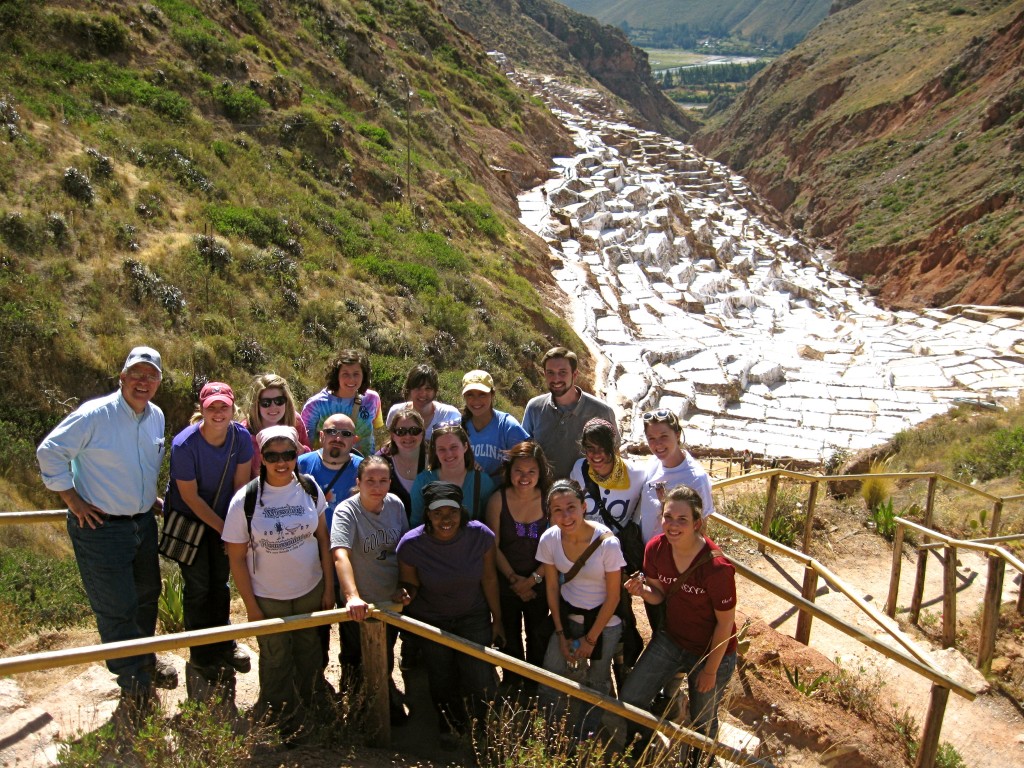
OU Journey to Latin America students stopped by a salt mine on the way to Moray.

Here I am at Moray, the Incas' research field.
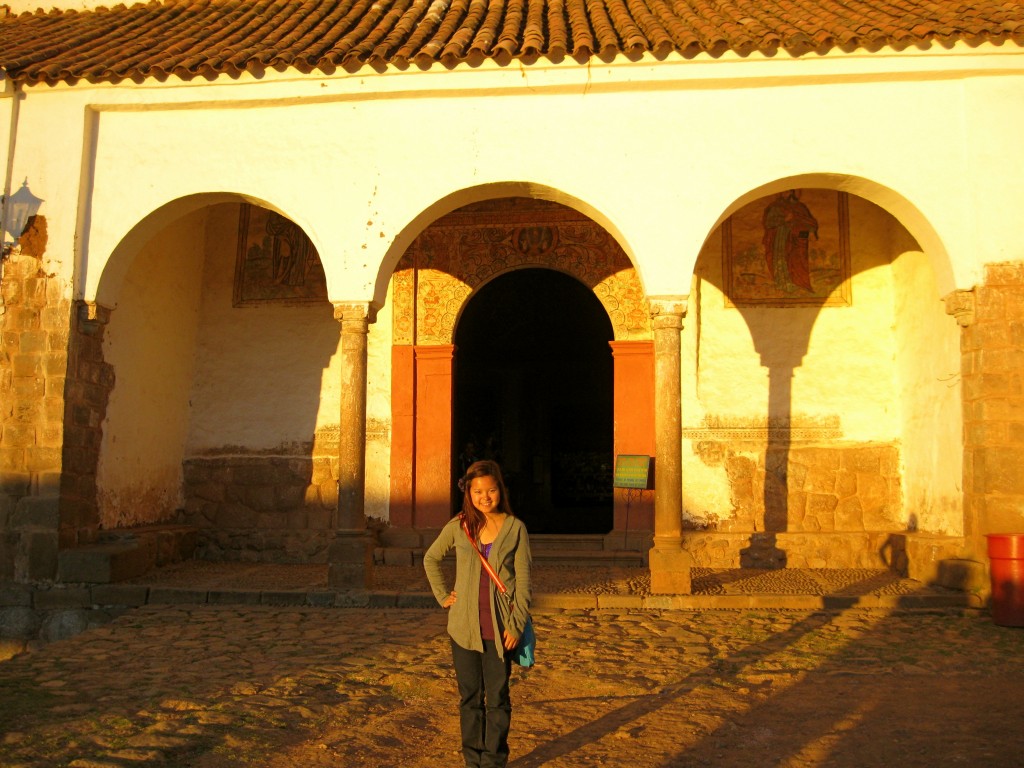
Chinchero Catholic Church in Chinchero, Peru
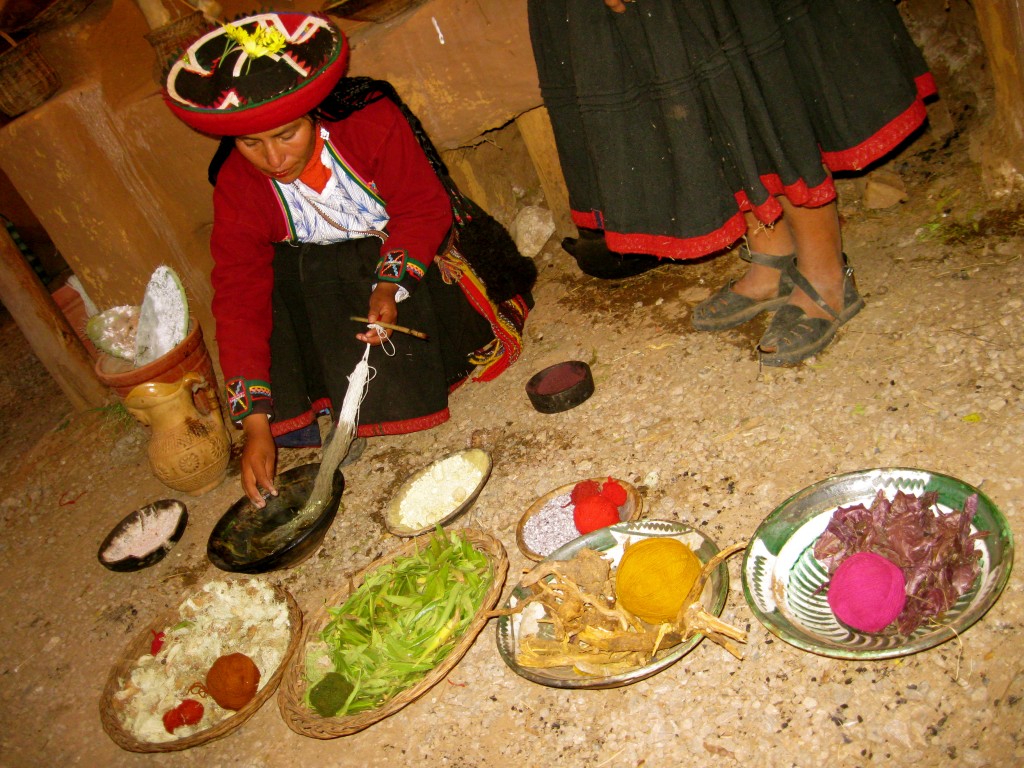
This textile factory in Chinchero was slightly different than the one in Patacancha because it was bigger. One of the leaders of the textile factory spoke Spanish, Quechua and English. The women gave us a full demonstration of how each color of dye is made. They also served us tea and demonstrated weaving techniques.

We all enjoyed our meals and had a great time conversing and getting to know each other at our first dinner in Cuzco.
I had WiFi for the first time in four days, but it didn’t work for me to post any blogs!
The past few days have been crazy dragging around luggage, hiking everywhere and staying in different towns every night.
We visited four towns today, but we are settled in Cuzco for the next four days!
We traveled from Machu Picchu town to Ollantaytambo to Chinchero to Cuzco, stopping at a salt mine, Moray (the Incans’ research field), Chinchero town and church and an indigenous textile factory. So much fun in one day!
This textile factory in Chinchero was slightly different than the one in Patacancha because it was bigger. One of the leaders of the textile factory spoke Spanish, Quechua and English. The women gave us a full demonstration of how each color of dye is made. They also served us tea and demonstrated weaving techniques.
We all bought many textile items from this factory because there were more vendors and items for sale.
We arrived at our hotel in Cuzco, Casa Campesina (“the peasants’ home”) around 8 p.m. We then unloaded our stuff and walked around Cuzco looking for dinner.
We returned from dinner around 11 p.m. As fun as Peru is, customer service is not so great. It’s usually very slow with misunderstanding partly due to language issues.
For example, Jenny and Ravae asked for free pisco sours that came with our dinners. Ravae asked the server three times if the pisco she was ordering is free because that’s all she wanted, and the server said “yes.” The server came back with free pisco sours and two other pisco sours for Ravae and Jenny. Señora Marchand, Dr. Kenney’s wife, explained to the server that the girls only wanted the free drinks, but the server got mad and stormed off.
The server later came back and said she could not take the drinks back because they were ordered and would be charged. Señora Marchand made a compromise: the server took one of the drinks back, and the girls paid for the other.
I found this situation interesting because I have never seen this happen in the United States. I have worked as a server, and I have never acted this way toward customers. We always treated the customers as if they are always right. I never asked the customer to pay for something if there was a misunderstanding, and managers often apologize and give the item to the customer.
In the end, we all enjoyed our meals and had a great time conversing and getting to know each other.
We also left good tips so that the server had enough money to pay for the other pisco sour.
Dr. Kenney likes to joke with us. I’d like to leave this blog entry with a quote from him:
“Let’s leave while Chinh’s in the restroom. She’ll be a lost Hello Kitty. Cats don’t have very big brains, do they?”
My professor is picking on me while abroad, but at least he’s comparing me to my happy little bow-wearing friend, Hello Kitty!
Plus, we all know Hello Kitty and I are very intelligent. 🙂
Jun
19
A review of Tuesday, June 15, 2010
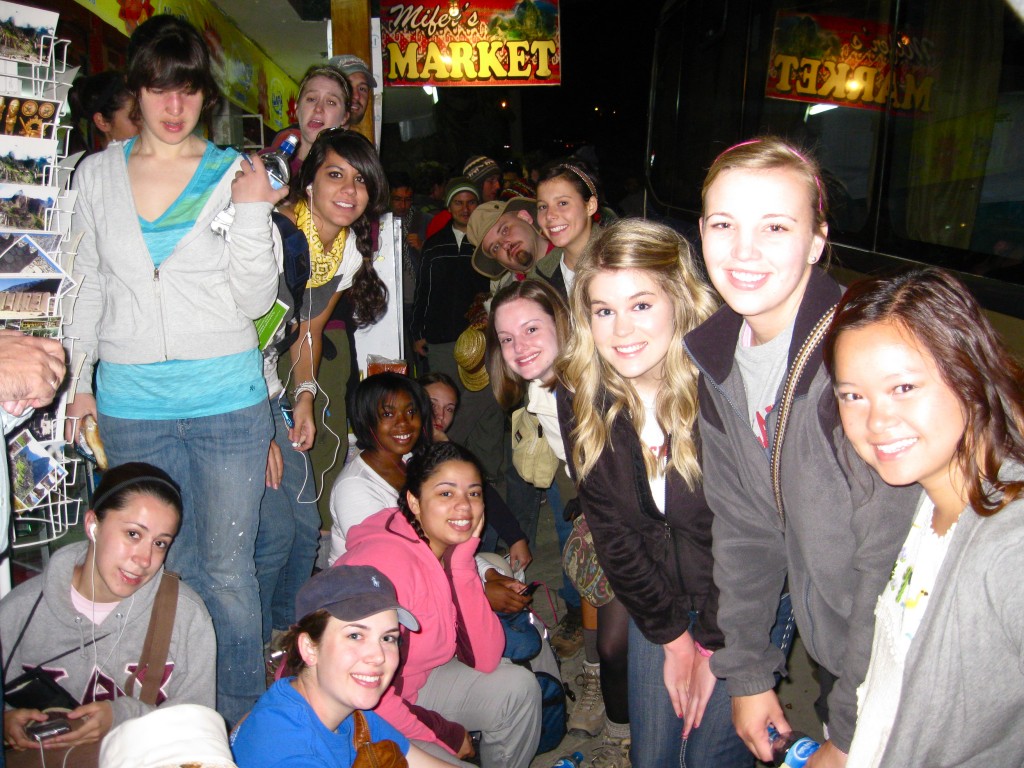
I woke up at 3:30 a.m. to get ready for our big day in Machu Picchu town. We met in the lobby of the Andina Hotel at 4:30 to walk to the bus stop. We all waited at the bus stop until about 6 a.m. when we were allowed to board the bus that would take us to Machu Picchu.

It was amazing to see Machu Picchu early in the morning before everyone else. We also saw the sunrise.

I’m so glad I pushed myself to climb Wayna Picchu even though I am scared of heights and even though it was physically exhausting. I'm also proud of all my traveling buddies for climbing to the top! We all helped each other climb to the top by encouraging and waiting for each other.
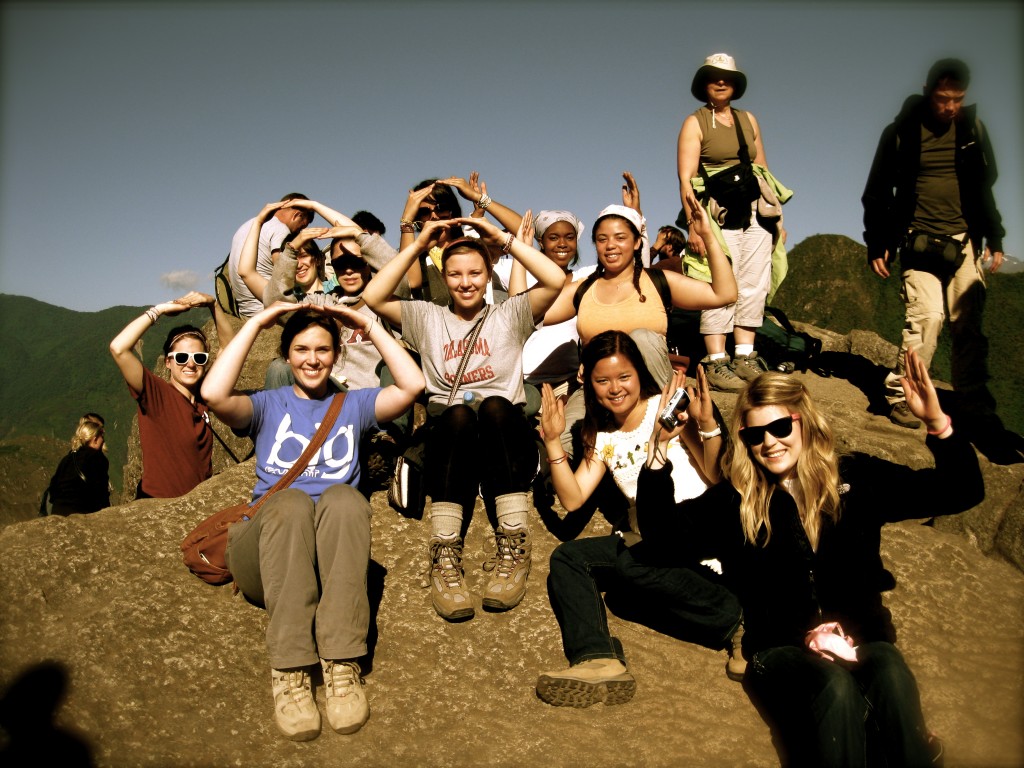
It took me about 45 minutes, the average time, to climb to the top of Wayna Picchu. I spent about 45 minutes on top of Wayna Picchu relaxing, taking pictures and absorbing it all in. Boomer Sooner!

I met two Tri Delta sisters from Baylor and Emery, so of course we threw up the Delta in the Inca ruins! Here I am with Laura, a graduate of Baylor University.

After eating and catching our breath, we walked around Machu Picchu for about 2 hours!

There are few things like seeing the sun come up at Machu Picchu and later enjoying the sunshine after a long hike up a mountain.
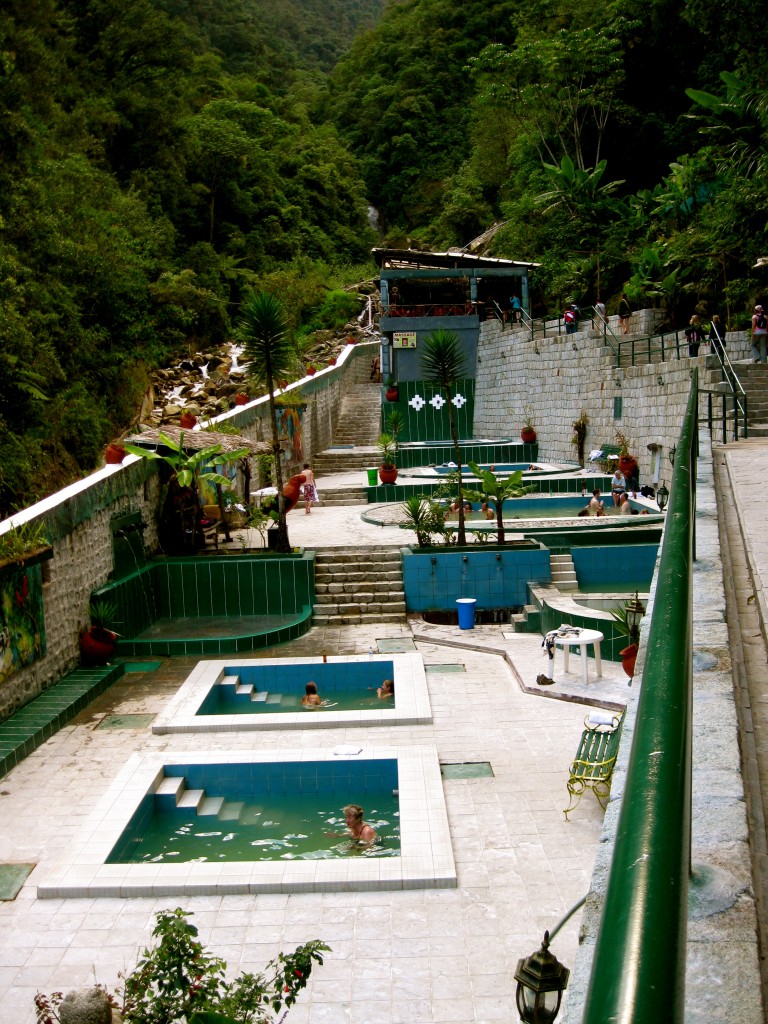
After all the Wayna Picchu and Machu Picchu fun, Rafael and his wife showed us to the “baños termales,” hot baths in Machu Picchu town, also known as Aguas Calientes.

Our interesting dinner experience that lasted about 3 hours from taking our orders to paying for the meals.
I woke up at 3:30 a.m. to get ready for our big day in Machu Picchu town. We met in the lobby of the Andina Hotel at 4:30 to walk to the bus stop.
We all waited at the bus stop until about 6 a.m. when we were allowed to board the bus that would take us to Machu Picchu. When we got to the Machu Picchu site, it was still dark, and we waited in line to show our ticket and ID. Only 400 (200 for the earlier shift, and 200 for the later shift) people are allowed to climb Wayna Picchu. When we got our stamps for Wayna Picchu, we were about the 100th, but we were about the 10th people that day to climb because some people in front of us waited later to climb.
The climb was beautiful because the sun was rising, but it was one of the hardest, most physical things I’ve done in college. I played volleyball and tennis in high school, but I haven’t been working out. I also haven’t climbed a mountain.
It took me about 45 minutes, the average time, to climb to the top of Wayna Picchu. I spent about 45 minutes on top of Wayna Picchu relaxing, taking pictures and absorbing it all in.
I’m so glad I pushed myself to climb Wayna Picchu even though I am scared of heights and even though it was physically exhausting. I’m also proud of all my traveling buddies for climbing to the top! We all helped each other climb to the top by encouraging and waiting for each other.
Rafael carried some of the girls’ things because they were getting heavy. He stayed at the back of the trail to make sure everyone was safe.
Our tour guide, Saúl, has climbed Wayna Picchu about 15 times. His fastest time is 9 minutes. I’d like to think he’s this quick because he’s a descendent of the Incas. 😀
We all took a lunch break at the café at the entrance of Machu Picchu. The food prices were outrageous since tourists are more likely willing to pay high prices. For example, a bottle of water cost 8 soles when it normally costs about 2 soles in a neighborhood store. I ordered a chicken sandwich combo that included passion fruit juice and soft-serve ice cream. YUM!
After eating and catching our breath, we walked around Machu Picchu for about 2 hours! There are few things like seeing the sun come up at Machu Picchu and later enjoying the sunshine after a long hike up a mountain.
I met two Tri Delta sisters from Baylor and Emery, so of course we threw up the Delta in the Inca ruins!
After all the Wayna Picchu and Machu Picchu fun, Rafael and his wife showed us to the “baños termales,” hot baths in Machu Picchu town, also known as Aguas Calientes.
I was not very impressed with the hot baths because I pictured more natural thermal hot springs. This was more like giant man-made Jacuzzis. I’m still glad I went to know what it was like.
Jenny, Andy and I left the hot baths early to walk around Machu Picchu town. Andy and Jenny used an Internet café while I wrote postcards.
I mailed the postcards, then Jenny and I explore the Machu Picchu market and walked around the neighborhood.
We all met later that night to have dinner. The dinner experience was something different. The man at the front of the restaurant told us we could order anything off the menu for 20 soles with drink (Pisco sour, lemonade or tea) included. We made sure he was telling the truth because we fell for “free drinks” before in Lima.
The food was tasty for the most part, and the man kept his promise, but it took us about an hour to get our free drinks and water. Then it took about another hour to get our food.
The most absurd part of dinner was that the restaurant only had one young lady working as cook, cashier and hostess while the man continued to stand at the entrance asking people to come in. It was obvious this restaurant could not handle more customers.
The hostess/cook/cashier came in and out of the restaurant several times carrying groceries after she took our order. It was as if the restaurant didn’t have the ingredients even though they invited us in and took our orders.
The most frustrating part was that the hostess said we couldn’t pay separately although she said we could at the beginning. After she understood that we couldn’t pay unless we paid separately, she asked us all to write down what we ate because she couldn’t remember. I’m not sure why this mattered when everyone’s meals cost 20 soles as promised.
After we wrote our meals down on torn pieces of paper, she said she had to go next door to swipe the charge cards. Why did she have to use another business’ charge machine when the man said the restaurant accepts charge cards, and the entrance displayed Visa signs?
After about 30 minutes of waiting for our cards, change and receipts, a child came into the restaurant holding Ashley’s debit card. This frustrated Ashley because the young girl was running around with her only source of money. What if the young girl lost the debit card?
Because the charge machine next door had so much trouble, everyone borrowed money from each other to pay in cash. The young lady then said everyone’s meals cost 22 soles instead of 20 soles because tax was not included.
The dinner lasted about 3 hours from taking our orders to paying for the meals.
After that fiasco, we all returned to our hotels to sleep.
Jun
19
A review of Monday, June 14, 2010
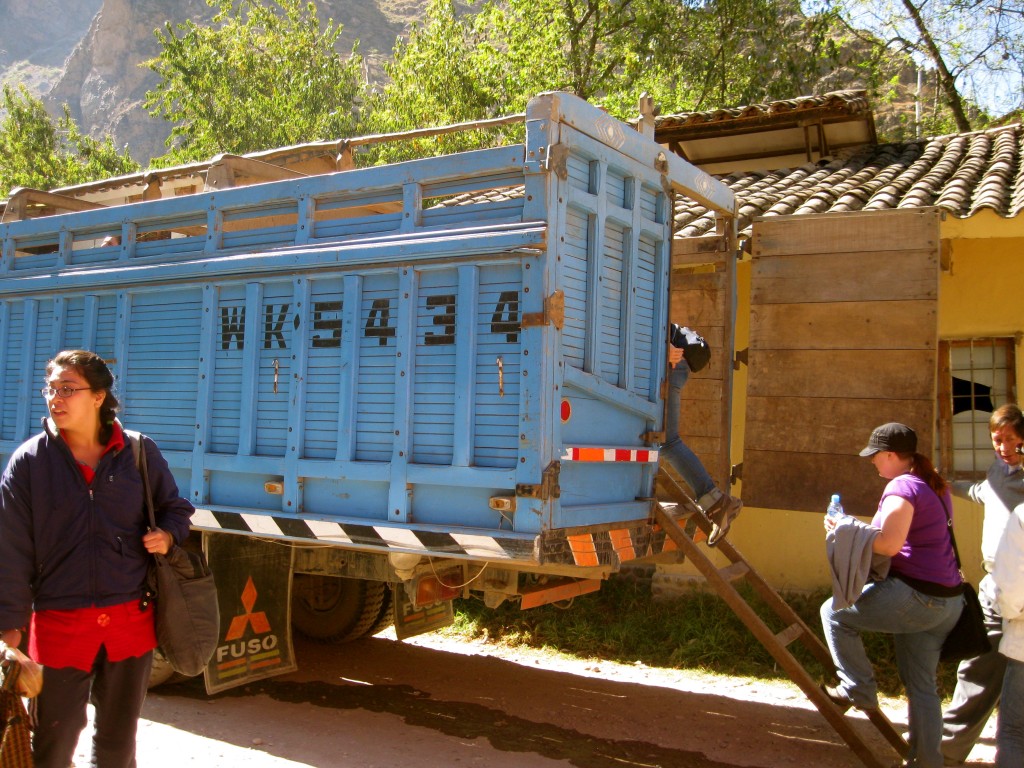
My favorite part the past few days: 17 OU students, two OU professors, a tour guide and two workers from a textile factory riding up a mountain in a cattle truck on narrow, dusty roads chasing cows, sheep and whatever in our way. Oh, and picking up other tourists and indigenous people on the way.

It was especially fun because I sat on the top of the cattle truck on the way there and back, so I saw different views. What a fun 2-hour ride!
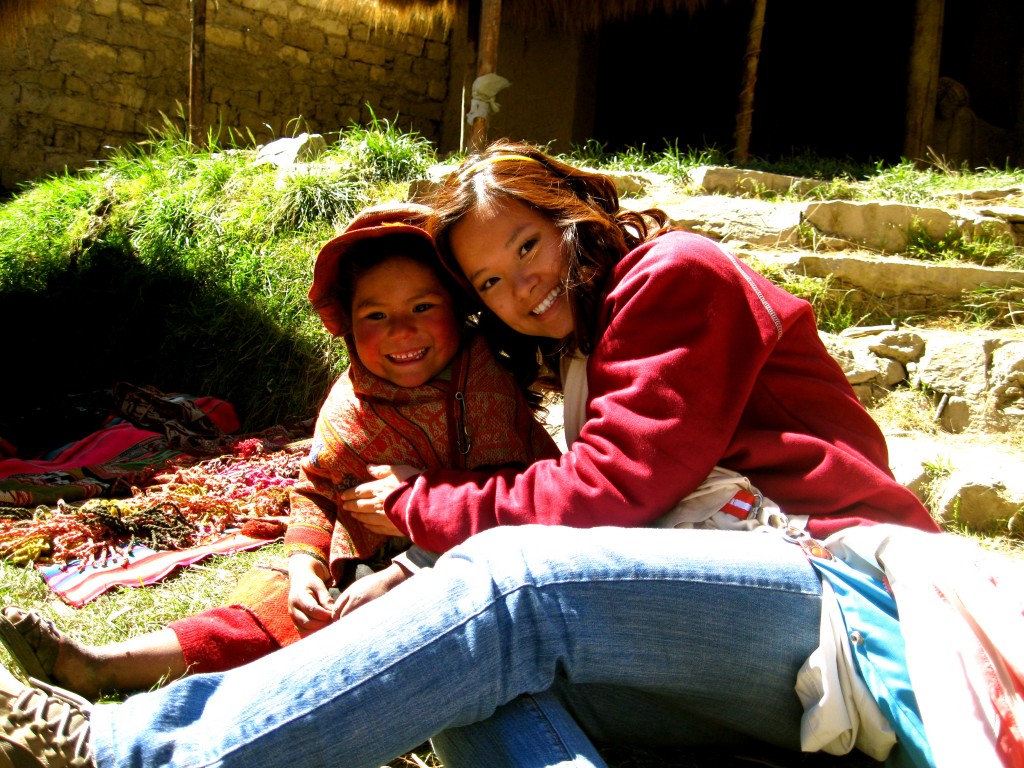
I played with the children at the Patacancha textile factory, particularly a 3-year-old girl who was very happy and giggly.
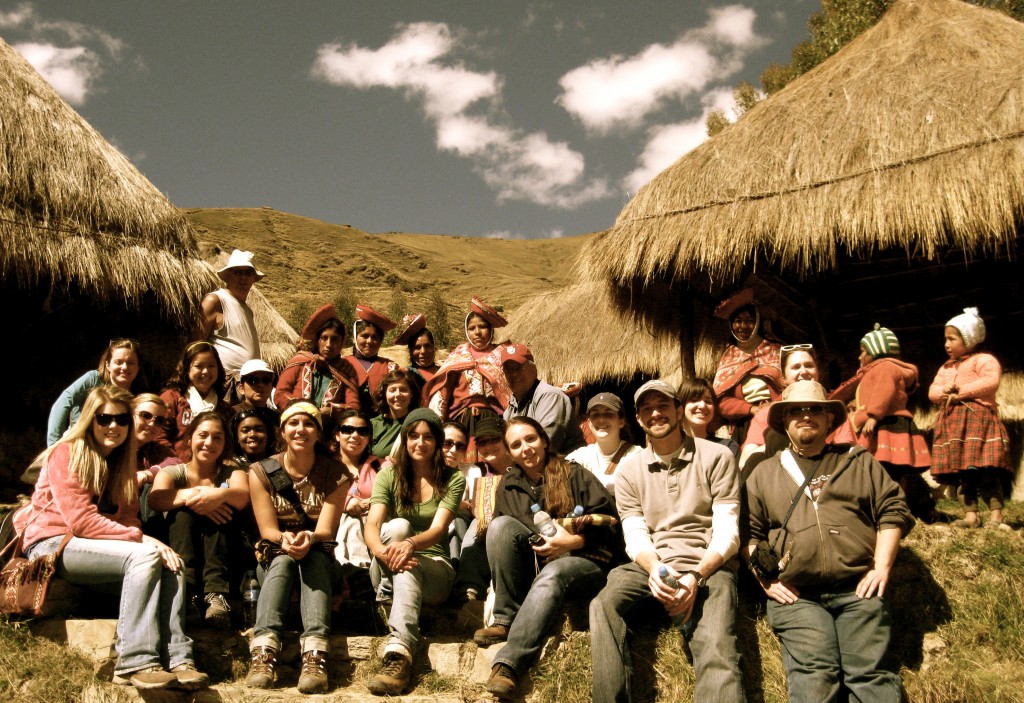
There were about five children with their mothers at the textile factory, which consists of huts. The only man in the factory spoke Quechua and Spanish. He helped prepare the spool so the women could make products out of it.
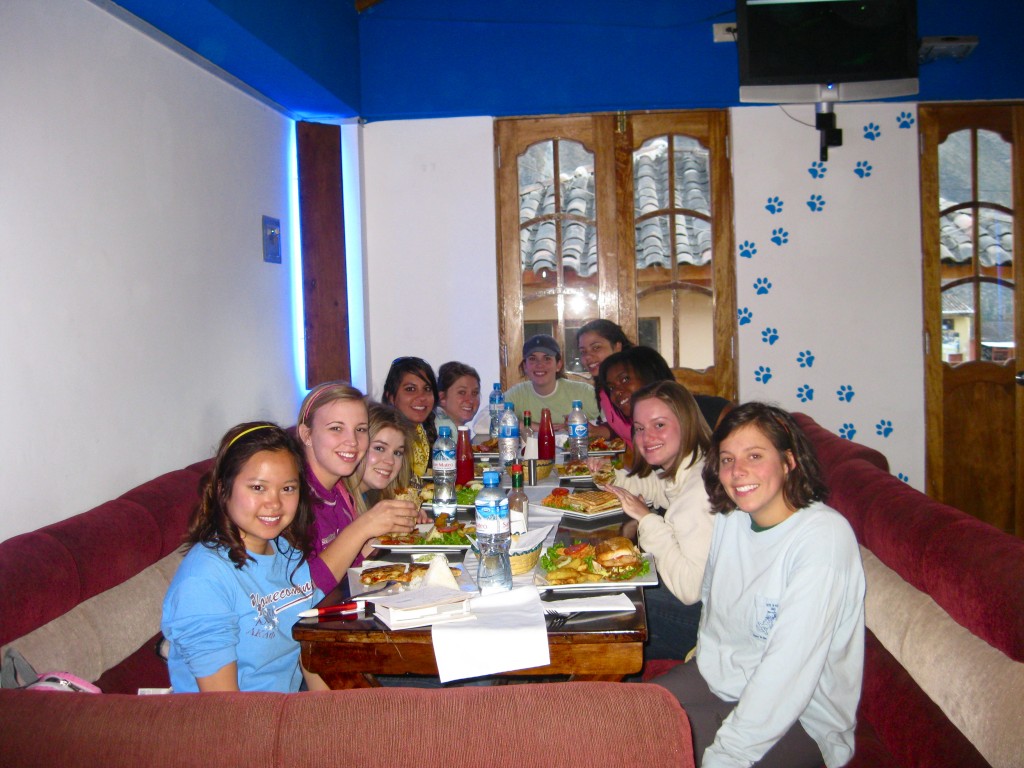
We returned to Ollantaytambo town. Most of us ate at a restaurant called Blue Puppy. I had shrimp quesadilla, one of the few Mexican food options I have seen here in Peru.
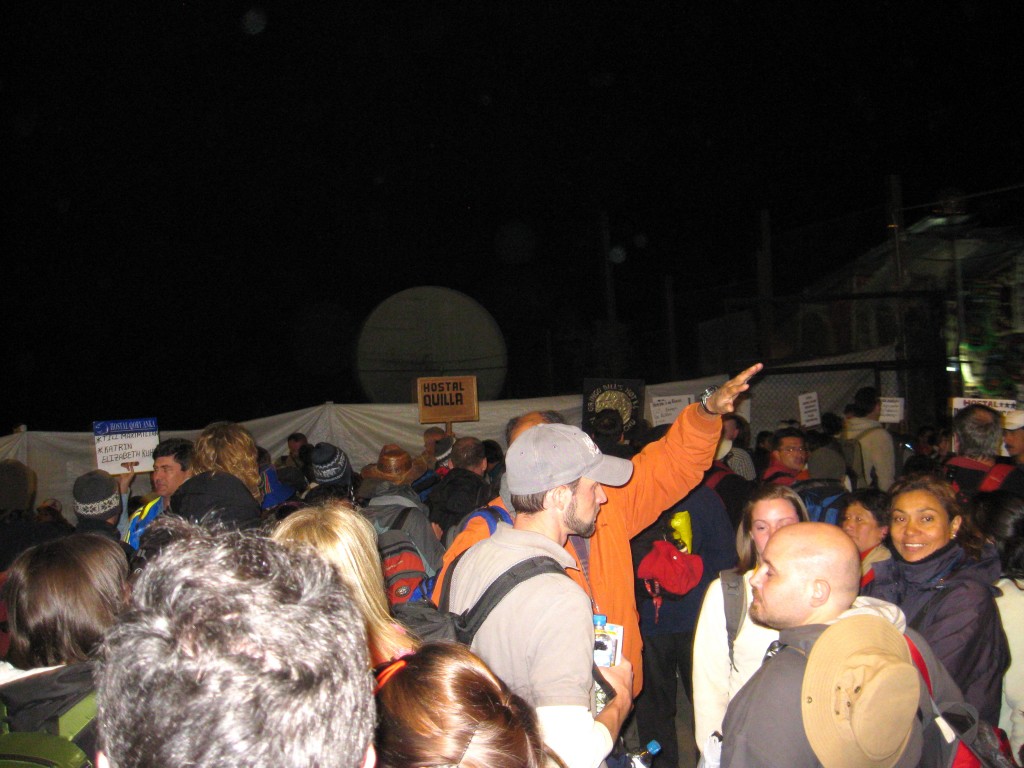
After a hike, a bus ride and a train ride, we made it to Machu Picchu town. Then we divided up into two groups, walked to our hotels and rested for the big day.
Today was very exciting!
My favorite part the past few days: 17 OU students, two OU professors, a tour guide and two workers from a textile factory riding up a mountain in a cattle truck on narrow, dusty roads chasing cows, sheep and whatever in our way. Oh, and picking up other tourists and indigenous people on the way.
It was especially fun because I sat on the top of the cattle truck on the way there and back, so I saw different views. What a fun 2-hour ride!
The director of the textile factory, Emma, is from Great Britain. She’s in her 20s, and she was helpful and welcoming.
I had a great time learning about Patacancha town and the textile factory. Patacancha, consisting of 473 members, is in the mountains of Ollantaytambo town.
There were about five children with their mothers at the textile factory, which consists of huts. The only man in the factory spoke Quechua and Spanish. He helped prepare the spool so the women could make products out of it. I played with the children, particularly a 3-year-old girl who was very happy and giggly.
The women showed us how to dye the wool and how to make different textiles. We later had the opportunity to buy their products.
The non-profit organization that runs the textile factory prepared bagged lunches for us, and the Andean women cooked us potatoes. I gave one of my sandwiches to the 3-year-old girl, and she quickly ate it. I gave an apple to a younger boy. I took a bite of the potato and found a worm in it. I didn’t eat any potatoes after that.
The area doesn’t have indoor plumbing, so our restrooms consisted of bushes. My small bladder forced me to use the “natural restrooms” twice, but I had traveling companions to accompany me…talk about bonding.
We walked further up the mountains and had a great view of Patacancha town and saw the school and soccer field.
We returned to Ollantaytambo town. Most of us ate at a restaurant called Blue Puppy. I had shrimp quesadilla, one of the few Mexican food options I have seen here in Peru, and later mailed six postcards.
Each stamp costs 5.50 soles (about $2). I printed about 40 address labels for postcards before leaving for the trip, but I won’t be mailing that many after finding out how much each stamp costs. The man told me it takes about 10 days to get to the United States.
We took the luggage we would need for the next few days and hiked to the bus station that would take us to the train station for Machu Picchu. After a hike, a bus ride and a train ride, we made it to Machu Picchu town. Then we divided up into two hotels, walked to our hotels and rested for the big day.


